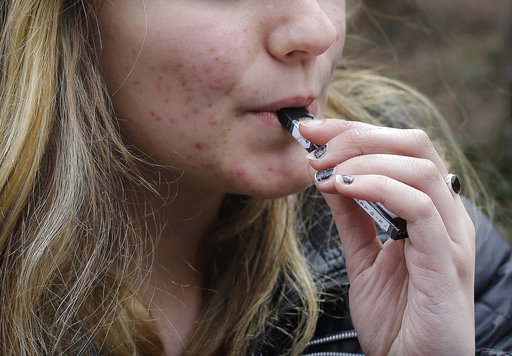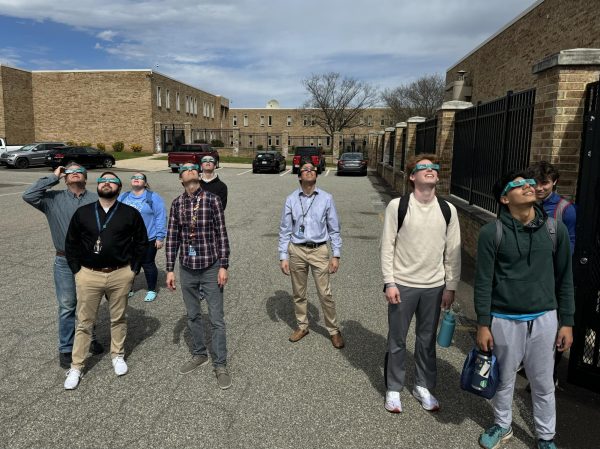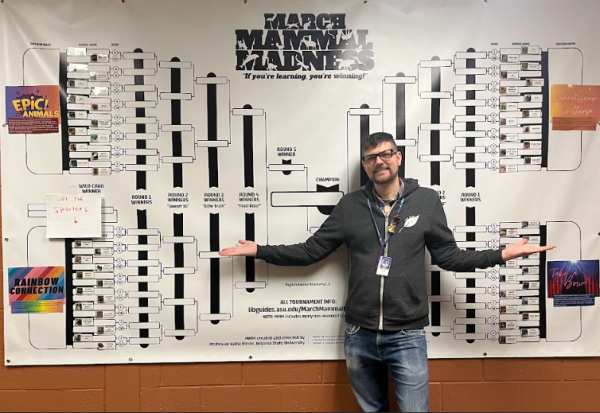The Real Cost of Vaping

FILE – In this April 11, 2018, file photo, an unidentified 15-year-old high school student uses a vaping device near the school’s campus in Cambridge, Mass. A school-based survey shows nearly 1 in 11 U.S. students have used marijuana in electronic cigarettes, heightening concern about the new popularity of vaping among teens. E-cigarettes typically contain nicotine, but results published Monday, Sept. 17, mean a little more than 2 million middle and high school students have used the devices to get high. (AP Photo/Steven Senne, File)
This month, the Food and Drug Administration announced a program called The Real Cost, with the intent of curbing the rise of e-cigarette and vape use among teenagers. The FDA calls this trend of vaping an “epidemic” and puts the blame on large vaping manufacturers like Juul.
A vape or e-cigarette does not burn tobacco. It actually forms an aerosol by heating a e-liquid with a metallic coil. This reaction creates a cloud of water vapor released from the mouth.
The Real Cost program aims to educate the youth on the dangers of e-cigarettes through advertising on social media networks, as well as placing posters around high schools that discourage the use of these products. Over 2 million middle school and high school students use e-cigarettes, which can be credited to the variety of flavored vape liquids. These flavors include peppermint, cotton candy, and other fruity flavors.
Many e-cigarette products do contain nicotine, which has parents and school administrators worried for the health of teenagers. Nicotine puts teenagers at risk of addiction by rewiring the brain to release dopamine once nicotine enters the bloodstream. Dopamine causes a euphoric feeling, but that feeling disappears, causing the body to crave more. These e-cigarette products were put on the market with the intent of helping adult cigarette smokers quit smoking and find a safer alternative to smoking.
“Even as we consider the potential benefits of innovative tobacco products and the role that some such products may play in reducing harm to current adult smokers, the FDA won’t tolerate a whole generation of young people becoming addicted to nicotine as a tradeoff for enabling adults to have unfettered access to these same products,” commented FDA Commissioner, Scott Gottlieb.
Secondary school administrators across the nation are experiencing the effects of the increased use of e-cigarettes among teenagers, including administrators at North Penn High School.
“We honestly have not seen any cigarettes or any traditional smoking in the bathroom in a couple of years, but vaping has gone up greatly. I think it is easier for students to hide because it is not that strong smoke of a cigarette… it is a little easier to mask, so I think it makes it easier for students to at least try and get away with it,” explained Pete Nicholson, Principal of North Penn High School.
Students who are caught smoking e-cigarettes or vaping during school may face a penalty of a one day in school suspension. The penalty depends on extenuating circumstances and if the student has repeated offenses.
“It definitely worries me. Anytime you put something in your body that is not meant to be in your body… it could be a health concern. I am worried what the long term research is going to show,” explained Nicholson regarding the possible dangers of vaping.
Consumers of e-cigarettes and vapes believe there is no harm in using these products. In reality, there is little information to conclude whether vaping is truly harmless. This is due to the fact that e-cigarettes and vapes are relatively new to the market. There is simply not enough time to conduct long term scientific studies that will show the possible dangers of vaping and e-cigarette use.










